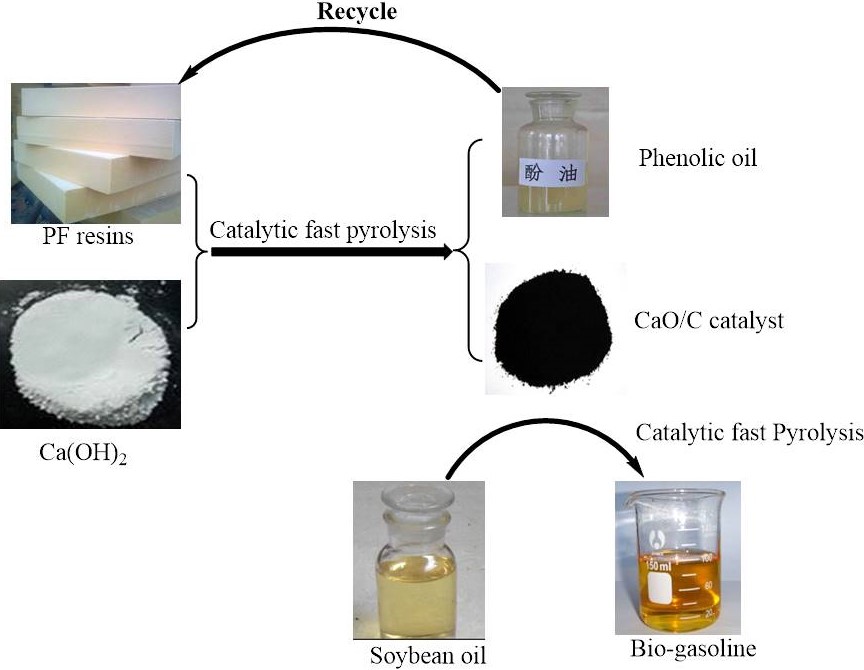Co-production of phenolic oil and deoxidation catalyst via fast pyrolysis of phenol-formaldehyde resin with Ca(OH)2
Recently, Dr. Lujiang Xu and Prof. Zhen FANG have developed a catalytic pyrolysis process for direct conversion of phenol-formaldehyde resin to produce phenolic oil and deoxidation catalyst.

PF resins were used to co-produce phenolic oil and CaO/carbon catalyst by fast pyrolysis with Ca(OH)2 with oil yield of 37% containing 80% phenols (Ca(OH)2催化热解酚醛树脂共生产酚醛油和CaO/炭催化剂,油产率为37%,含80%酚类).
Phenol-formaldehyde (PF) resin was widely used in industry, it would cause an adverse effect on the environment if without applicable treatments of resin wastes. Triglycrides (e.g., soybean oil) were abundant in the nature, but cannot be used directly as engine fuel. The deoxygenation of triglycrides was necessary for producing liquid fuel similar to that derived from petroleum. Herein, PF resin was used to co-produce phenolic-rich oil and CaO/char deoxygenation catalyst by catalytic fast pyrolysis with Ca(OH)2. The CaO/char was used as catalyst to catalytic deoxygenation of soybean oil via catalytic fast pyrolysis process. It was found that Ca(OH)2 changed the thermal decomposition behaviours of PF resin dramatically and promoted the cracking reactions to form more monophenol compounds. The optimal conditions for producing phenol-rich oil (containing 9.1% aromatic hydrocarbons and 82.8% phenols, GC-MS area fraction) with 37.3% yield were 650 °C and 5.0% Ca(OH)2 catalyst. Meanwhile, the total carbon yield of targeted phenols reached 33.7%. Solid residue (char) was further pyrolyzed at 800 °C for producing CaO/char catalyst that helped to reduce the bio-oil oxygen content from 14.4% to 2.4% in the pyrolysis of soybean oil. The peak area % of aromatic hydrocarbons in the oil was 86.8%, and indicated it could be used as gasoline. Phenolic oil from PF resin and aromatic hydrocarbons-rich oil from vegetable oil are easily produced by fast pyrolysis with calcium catalyst.
Related results were published:
LJ Xu, QQ Zhong, Q Dong, LY Zhang, Zhen Fang*, Co-production of phenolic oil and CaO/char deoxidation catalyst via catalytic fast pyrolysis of phenol-formaldehyde resin with Ca(OH)2, Journal of Analytical and Applied Pyrolysis, https://doi.org/10.1016/j.jaap.2019.104663 (2019).
------------------------------------------------------------------------------------------
催化热解酚醛树脂共生产酚醛油和CaO/炭催化剂
最近,徐绿江博士和方真教授开发了一种直接转化酚醛树脂生产酚醛油和脱氧催化剂的催化热解工艺。
酚醛树脂在工业上得到了广泛的应用,如果不进行适当的处理,会对环境造成不良影响。甘油三脂(如大豆油)在自然界中含量丰富,但不能直接用作发动机燃料。甘油三脂的脱氧对于生产类似于石油液体燃料是必要的。在此基础上,采用酚醛树脂与Ca(OH)2催化快速热解制备了富酚油和CaO/炭脱氧催化剂。以氧化钙/炭为催化剂,采用催化快速热解法对大豆油进行催化脱氧。结果表明,Ca(OH)2能显著改变酚醛树脂的热分解行为,促进裂解反应形成更多的单酚类化合物。
合成37.3%高酚油(含9.1%芳烃和82.8%苯酚)的最优条件为 650℃和5.0%Ca(OH)2催化剂。同时,目标酚的总碳产率达到33.7%。在800℃下对固体残渣(炭)进行进一步热解,制备出CaO/炭催化剂。该催化剂使豆油热解过程中生物油氧含量由14.4%降至2.4%。油中芳烃的GC-MS峰面积百分比为86.8%,表明它可以作为汽油使用。酚醛树脂制备酚醛油和植物油制备富芳烃油,在钙催化剂的作用下,通过快速热解得以实现。
详情可见:
LJ Xu, QQ Zhong, Q Dong, LY Zhang, Zhen Fang*, Co-production of phenolic oil and CaO/char deoxidation catalyst via catalytic fast pyrolysis of phenol-formaldehyde resin with Ca(OH)2, Journal of Analytical and Applied Pyrolysis, https://doi.org/10.1016/j.jaap.2019.104663 (2019).

